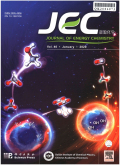- 钛学术文献服务平台 \
- 学术期刊 \
- 工业技术期刊 \
- 石油与天然气工业期刊 \
- 能源化学期刊 \
In-situ surface self-reconstruction in ternary transition metal dichalcogenide nanorod arrays enables efficient electrocatalytic oxygen evolution
In-situ surface self-reconstruction in ternary transition metal dichalcogenide nanorod arrays enables efficient electrocatalytic oxygen evolution
基本信息来源于合作网站,原文需代理用户跳转至来源网站获取
摘要:
Water splitting has received more and more attention because of its huge potential to generate clean and renewable energy.The highly active and durable oxygen evolution reaction(OER)catalysts play a deci-sive factor in achieving efficient water splitting.The identification of authentic active origin under the service conditions can prompt a more reasonable design of catalysts together with well-confined micro-/nano-structures to boost the efficiency of water splitting.Herein,Fe,Co,and Ni ternary transition metal dichalcogenide(FCND)nanorod arrays on Ni foam are purposely designed as an active and stable low-cost OER pre-catalyst for the electrolysis of water in alkaline media.The optimized FCND catalyst demonstrated a lower overpotential than the binary and unary counterparts,and a 27-fold rise in kinetic current density at the overpotential of 300 mV compared to the nickel dichalcogenide counterpart.Raman spectra and other structural characterizations at different potentials reveal that the in-situ surface self-reconstruction from FCND to ternary transition metal oxyhydroxides(FCNOH)on catalyst surfaces initiated at about 1.5 V,which is identified as the origin of OER activity.The surface self-reconstruction towards FCNOH also enables excellent stability,without fading upon the test for 50 h.

推荐文章
In-situ sulfur isotope and trace element of pyrite constraints on the formation and evolution of the
Nibao Carlin-type gold deposit
Pyrite
NanoSIMS
LA-ICP-MS
Sulfur isotopes
Genesis and soil environmental implications of intact in-situ rhizoliths in dunes of the Badain Jara
Rhizoliths
Calcification
Leptic regosols
Artemisia roots
Decomposition
Soil moisture
The in situ spectral methods for examining redox status of c-type cytochromes in metal-reducing/oxid
c-type cytochrome
In situ spectroscopy
Intact cells
Metal reducing bacteria
Fe(Ⅱ) oxidation bacteria
Re-Os dating of molybdenite and in-situ Pb isotopes of sulfides from the Lamo Zn-Cu deposit in the D
Molybdenite Re-Os dating
In-situ lead isotopes
Skarn deposit
Dachang
内容分析
关键词云
关键词热度
相关文献总数
(/次)
(/年)
引文网络
引文网络
二级参考文献 (0)
共引文献 (0)
参考文献 (0)
节点文献
引证文献 (0)
同被引文献 (0)
二级引证文献 (0)
2021(0)
- 参考文献(0)
- 二级参考文献(0)
- 引证文献(0)
- 二级引证文献(0)
引文网络交叉学科
相关学者/机构
期刊影响力
能源化学
主办单位:
中国科学院大连化学物理研究所
中国科学院成都有机化学研究所
出版周期:
双月刊
ISSN:
2095-4956
CN:
10-1287/O6
开本:
出版地:
大连市中山路457号
邮发代号:
创刊时间:
语种:
eng
出版文献量(篇)
2804
总下载数(次)
0
总被引数(次)
7996
期刊文献
相关文献
推荐文献
- 期刊分类
- 期刊(年)
- 期刊(期)
- 期刊推荐
一般工业技术
交通运输
军事科技
冶金工业
动力工程
化学工业
原子能技术
大学学报
建筑科学
无线电电子学与电信技术
机械与仪表工业
水利工程
环境科学与安全科学
电工技术
石油与天然气工业
矿业工程
自动化技术与计算机技术
航空航天
轻工业与手工业
金属学与金属工艺
能源化学2022
能源化学2021
能源化学2020
能源化学2019
能源化学2018
能源化学2017
能源化学2016
能源化学2015
能源化学2014
能源化学2013
能源化学2012
能源化学2011
能源化学2010
能源化学2009
能源化学2008
能源化学2007
能源化学2006
能源化学2005
能源化学2004
能源化学2003
能源化学2002
能源化学2001
能源化学2021年第9期
能源化学2021年第8期
能源化学2021年第7期
能源化学2021年第6期
能源化学2021年第5期
能源化学2021年第4期
能源化学2021年第3期
能源化学2021年第2期
能源化学2021年第12期
能源化学2021年第1期

 免费查重
免费查重










